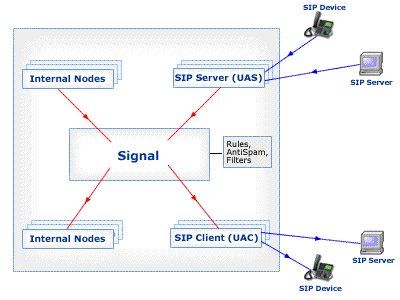The Signal Module supports several Event Packages. When it receives a SUBSCRIBE Request
targeting a local Account, it may process the Request itself, without forwarding it to the
Account registered entities.
The Signal module maintains "tuple" states for each Account, for each Event Package it supports.
The module allows one or several entities to update the "tuples", and it aggregates them into one
Account "state information" for the Package. When the aggregated "state information" changes,
the module sends NOTIFY requests with the updated state to all subscribed entities.
The Signal module allows external entities to modify "tuples" using PUBLISH requests.
The Signal module allows external entities to modify "tuples" for certain Packages using
non-standard SERVICE requests.
Presence
The Signal Module implements a Presence Server. The Module supports
the PIDF, CPIM-PIDF and XPIDF Presence Information formats.
The Signal Module provides special processing for the REGISTER requests. If an external
entity (a SIP device) indicates support for the SUBSCRIBE method, the module establishes
a presence subscription dialog with that entity.
The module then processes all NOTIFY requests sent by that entity to maintain
its Presence "tuple" or "segment".
A Presence segment value is a string from a fixed set, listed here starting from the lowest
priority value to the highest priority one:
- offline
- away
- out-lunch
- in-meeting
- be-back
- online
- on-phone
- busy
The event aggregated value is a segment value with the highest priority, or offline
if no segment exists.
When a NOTIFY request is composed, the aggregated value is converted into a presence document
in one of the supported formats.
Message Summary
The Signal Module implements the MWI (Message Waiting Indication) Service.
The Module supports the simple-message-summary Information format.
The Server itself maintains the "INBOX" tuple/segment for this Event package.
The segment value is set to an array:
- the first element is the number of INBOX messages that have the $Media flag set
and do not have the Seen flag set (the number of unread media messages);
- the second element is the number of INBOX messages that have the $Media flag set
(the total number of unread media messages);
The event aggregated value is an array containing the by-element sum of all segment
array values.
When a NOTIFY request using the simple-message-summary Information format
is composed, the first aggregated array element value is used as the number of new voice messages,
and the difference between the second and the first elements is used as the number of old voice messages.
If the first array element value is not zero, the Messages-Waiting element is set to
yes, otherwise it is reset to no.
